|
July
24, 2021 --
Mushrooms! Winecaps Arrive
I read and researched and last fall I
prepared two beds, then this spring bought spawn from nearby (Wisconsin)
Field and Forest.
The first bed is around one of our old Beacon apple trees. This was the
main reason for the project. Last summer I found out the nice wild
mushrooms growing around the tree that I had admired were a type one
doesn't want in one's orchard --
Armillaria mellea - Honey Fungus, root rot fungus.
The mycellium feeds on dead wood, then on into live wood, eventually
killing the tree. Oh my...
I did some research and came up with a
plan. (You can click on 'Orchard' - 'Apple' - 'Beacon' for more info if you are
interested). One part of the plan was to get a "friendly" but aggressive mycellium going around the tree to, in essence, "crowd out" the Honey
mushroom mycellium. To do that I chose the reportedly easy to grow Winecap
mushroom.
Others reported that Winecap was also a generous producer
of fruit but having not grown mushrooms before and really wanting it to "take
over" that area I put plenty of spawn in the bed the end of May. I
didn't expect to see mushrooms until fall but the instruction sheet did
say to keep an eye out for the fruit when there's a temperature drop and
rain, which is common here in the summer. It was unusually dry earlier
so I watered a lot. But we finally got 2 inches last week (and another inch last night
with more coming!) (I guess we're done with the drought). But it was a
surprise to suddenly see some small and medium mushrooms yesterday. A
couple were older but that was good because I wanted to do a spore print
just to make sure they were indeed Winecaps since we have wild mushrooms around.
Thankfully Winecaps are fairly easy to ID and what was growing looked
very true to the pictures. And the spores were indeed dark
purplish-black as they should be. So we had our first home-grown Winecap mushrooms in
dinner last night. Most reports I read suggested they are best at button
stage not later and that's what I harvested - all three of them. The
flavor was there though mostly they were lost in the dish. I hoped
we'd get a few more.
Well, as I mentioned, we had rain last
night/morning. When I walked by the tree today I was amazed to see the
results. There were mushrooms all over the bed! Folks had mentioned that once they get going one can get tired
of picking them but I hadn't taken that seriously. I think I see what
they mean now if this keeps up. Clothespin in the photos for size reference.
These all came up
just overnight.
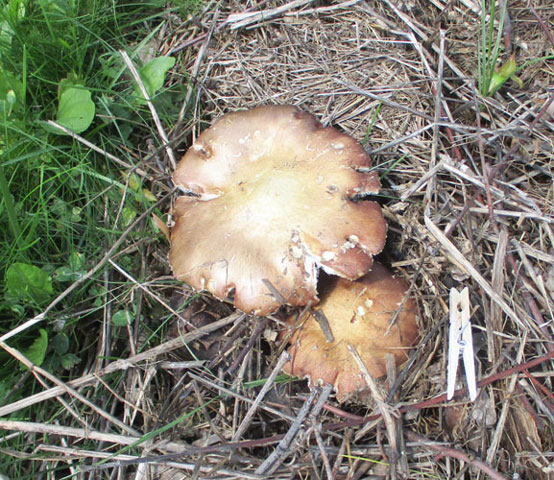
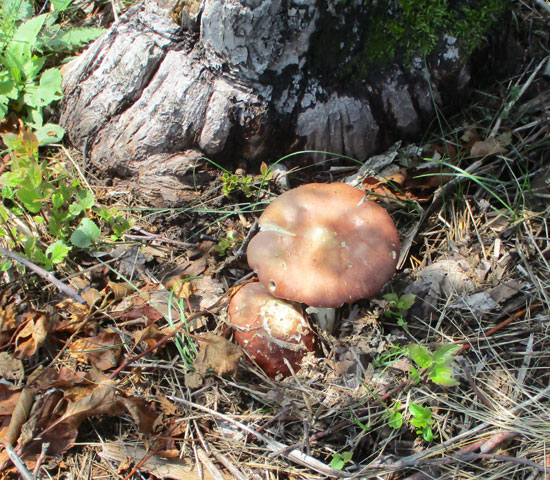

And there were more. So I decided to
dry some. I think I'll be doing a lot of that since they go beyond
button eating stage fast.
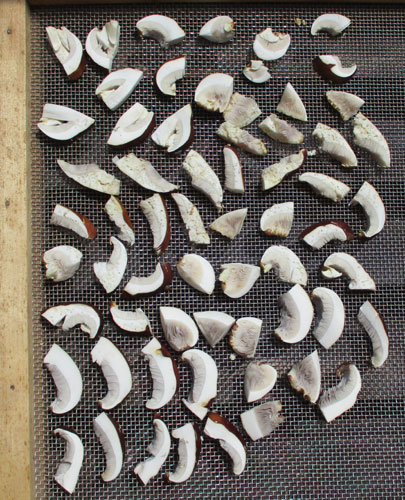
So plenty of mushrooms for homestead meals!
Wood Bluets -- The second bed was made on the north side of an
east-west row of raspberries at the south side of the garden. Wood Blewits in photos look attractive
(I hadn't seen one in real life) -- a
bluish-lilac-peachy color when younger, less color when older, meaty and
pleasant flavored. I'm not much of a mushroom connoisseur but I thought
it would be nice to have a mushroom that fruits in the colder fall to
follow the summer fruiting WineCap. Plus I liked the name -- Blewit.
In the fall I added more mulch than usual, using a mix of leaves, old
and new hay, grass clippings, small bark/wood trash from wood splitting.
It seemed like a lot but come spring when I put in the Wood Bluet spawn
it didn't seem like so much. I added stuff now and then through the
summer. I also did a lot of watering with the very dry season. They
are reported to be good at both the button and open stages, and are
preferred by many over the Winecaps. I kept an eye out for mushrooms all
summer but didn't see any. There didn't seem to be mycellium in the
mulch either. They did say it fruits in the fall but it can take till
next year to have mushrooms grow. I wondered if it had been too dry. But
then...
September 28 --
Since rain had been a bit sparse the last few weeks I decided I
better water the mushroom patches. So
I watered the mixed material of the mulch bed by the raspberries,
enjoying a really beautiful warm feels-like-August day.Then to my surprise I realized I'd just dumped
water on a mushroom! It was past prime, flat starting to turn up at the
edges, rather non-descript beige color, but a "new" mushroom
none-the-less. Could it be? Then farther on down the bed was another of
about the same age. I picked the better looking of the two and brought
it in to compare to photos and descriptions.
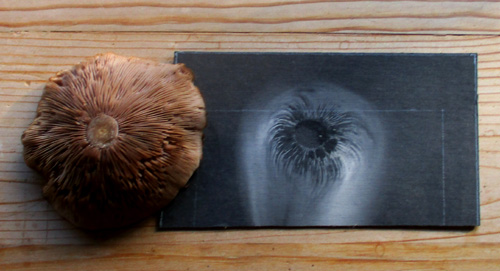 Though way past eating
stage it certainly sounded correct. I wouldn't eat one yet anyway until
I did a spore print to confirm. These mushrooms have a light colored
spore so I cut off the stem and set the cap gills down on a black card
figuring to leave it overnight. Though way past eating
stage it certainly sounded correct. I wouldn't eat one yet anyway until
I did a spore print to confirm. These mushrooms have a light colored
spore so I cut off the stem and set the cap gills down on a black card
figuring to leave it overnight.
But an hour later I came by and there it was, an
attractive white/light colored spore print. Apparently the mushroom was
at peak time to drop its spores. I find spore prints (all two of
them that I've done) to be fascinating. It would be fun to compare the
many wild
mushrooms though I think I'd rather leave the fruit where it is to be admired.
From then on I kept a look-out for fresh new Blewits
to admire and to eat but didn't find any. Then later when I was pruning
the old canes out of the raspberry patch I came across two small Bluets
amongst the canes. I left them with the hope they would mature and drop
more spores. There is hope afterall for the patch.
April
20, 2020 - Chaga Tea
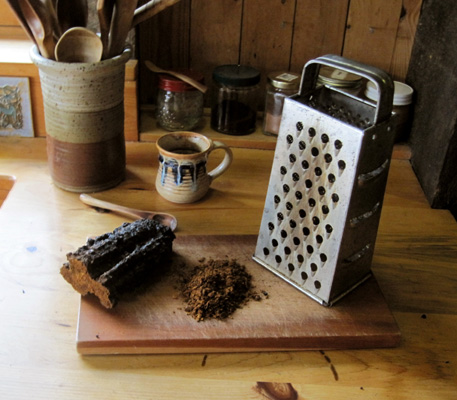 We were familiar with Chaga from several directions. Many years ago
we were involved in the local PowWow scene. Chaga was (is) a popular
pipe and incense ingredient, having a pleasant sweet smell and Native
American significance. And a friend uses it as a healing herb for
arthritis. But it was my fairly recent interest in growing edible
mushrooms that brought Chaga into our kitchen, and it didn't have far to
travel as it is growing on one of two large birch trees that flank the
back of our house. They were there when we chose this spot to put our
dwelling. The Chaga came later, growing in and around a fairly large
hole on the south side of one tree. We knew it was there, of course, but
didn't know it was a mushroom, albeit quite a hard one. It's not what
one normally thinks of as a mushroom. Our only thought about it was to
hope that if the tree chooses to break at that spot that it falls away
from the house. We were familiar with Chaga from several directions. Many years ago
we were involved in the local PowWow scene. Chaga was (is) a popular
pipe and incense ingredient, having a pleasant sweet smell and Native
American significance. And a friend uses it as a healing herb for
arthritis. But it was my fairly recent interest in growing edible
mushrooms that brought Chaga into our kitchen, and it didn't have far to
travel as it is growing on one of two large birch trees that flank the
back of our house. They were there when we chose this spot to put our
dwelling. The Chaga came later, growing in and around a fairly large
hole on the south side of one tree. We knew it was there, of course, but
didn't know it was a mushroom, albeit quite a hard one. It's not what
one normally thinks of as a mushroom. Our only thought about it was to
hope that if the tree chooses to break at that spot that it falls away
from the house.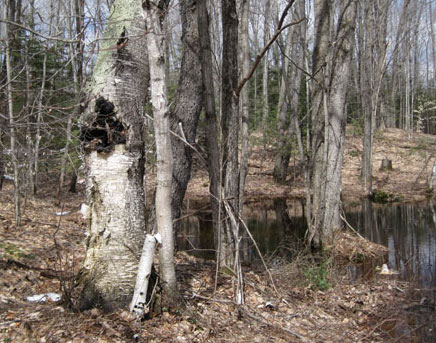
But in my reading of the ways of edible mushroom growing I came across a
piece on harvesting and processing Chaga for tea. That interested me so
I went over to our birch tree to see if I could get a piece of this hard
black mushroom. Thankfully it's within easy reach. Sure enough, a good
handful sized piece broke off without much trouble. Then I searched
online for some instructions on how to prepare it. My next big discovery
was that Chaga is definitively "in". There were posts all over, most
best ignored as is the way of the internet. But there were a few well
informed, personal experience sites so I read those and decided on my
own method.
Thankfully, it is not a difficult process. Using a kitchen grater I soon
had a little pile of what looked similar to rough coffee grounds. It
took a bit of muscle but was quite doable. I put a tablespoon or so in
water in a pan and put it on the woodstove to simmer, not knowing if I'd
even like it. I'm an herb tea woman, not much fond of coffee, and it
sounded like it was more coffee than herb tea. But I kept an open mind.
The brew turned a very dark color and I not only liked it, Steve did,
too. It's a bit of a mild bitter flavor but not overly so. A little
honey takes the edge off the bitter if you want. The next few times I
kept track of how much grated Chaga, how much water, and how long a
simmer so I could have some consistency in the future. It's not an exact
science considering the many variables of particle size, age of the
chunk, how much water, how hot, how long it simmers, etc. So it varied.
But it was fine every time, just a little more or less strong. The last
time I made it I used a heaping tablespoon of ground Chaga in 4 cups of
water, simmered for about an hour then left in the pan for maybe several
hours. Pour the very dark liquid off the grounds (which settle nicely at
the bottom) into a jar, and store in refrigerator (which in our case is
still the cool root cellar). Use as you wish. I like it straight thinned
with water, in a small cup made by a local potter, sipped throughout the
day or evening. Steve likes it in his everyday drink which is diluted
orange, or other, juice. As he uses a clear glass mug for this the color
is a bit odd but the flavor is good. He's tried it is his coffee and
that was OK, too, but as his coffee has other amendments he prefers the
Chaga in his juice drink.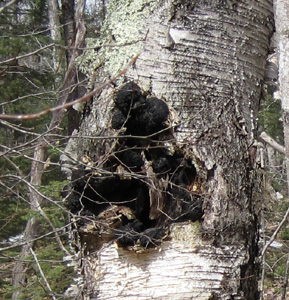
That first Chaga piece I harvested I hung in a cloth bag in the pantry
between gratings. But I was concerned about it getting mold as the
pantry was warming up now (mid 40's) and as hard as the Chaga seems it
is a live mushroom. Plus it was getting harder to grate as is dried. So
I grated up the rest of it, spread out and dried it in a glass cake pan
(which hasn't seen a cake in decades) by the woodstove, and stored it in
a jar. As I'd read one should only harvest when the Chaga is dormant
(late fall through late winter) I decided to break off another piece
right now, grate and dry it. It's much easier to grate when fresh. Our
Chaga on the tree isn't real large and I don't want to inhibit it from
continuing to grow so I didn't take too much - a small hand-full size
piece. But I now have 3 cups of the fresh dried grated Chaga mushroom to
keep us in brew (hopefully) till next harvest season. It's a nice
addition to the homestead world.
May 26, 2019 -- Finding Gold on the Homestead
A few days ago I was up at the mailbox (which is a half mile from our
house) and saw our neighbor slowly walking across her lawn, intently
looking down. Figuring she must have dropped something I walked over to
offer help. She showed me what she had in the paper bag in her hand.
Morels! And some nice ones at that, right in their lawn. Now we've only
found morels on our property a few times and that was many decades ago,
barely remembered. But then we've never searched for them either.
Inspired by our neighbor's find I walked back home, slowly, looking
carefully down and around as I went, getting distracted by any number of
interesting things. But I persevered and wandered around here and there
on the homestead where it seemed morels might be. Didn't find any, but
it was a nice wander.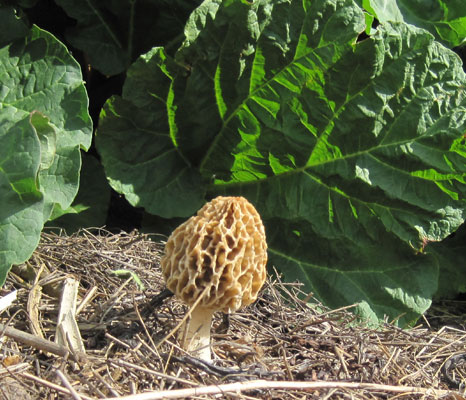
A few days later I was in the garden on hands and knees weeding a path
particularly well endowed with such things, intent in the job and
whatever was in my mind, getting towards the end. Sitting back on my
heels and looking ahead I saw, to my great surprise, just a few feet
away, a beautiful specimen of a morel, beautifully positioned in front
of the big green leaves of the rhubarb as if for a photo shoot. Well,
really! I stared at it for some moments, went closer and kneeled down -
was it really? Yep, that was one nice morel. I had to laugh, then went
to get Steve.
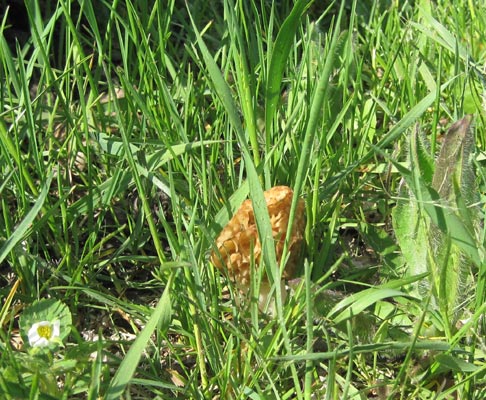 After all these years, right there in the garden. Well, they
do
say (and we do agree) that what is in your mind becomes in your life,
and morels had certainly been in my mind. When Steve came out he glanced
down near his feet and there close by on the south side of the rhubarb
was another morel, smaller but certainly edible size. Later I discovered
a still smaller one on the other side of the patch, nestled in the
grass. Why by the rhubarb? Maybe for no particular reason but it might
be because I often mulch the rhubarb with leaves in the fall. I shall
certainly continue that practice. After all these years, right there in the garden. Well, they
do
say (and we do agree) that what is in your mind becomes in your life,
and morels had certainly been in my mind. When Steve came out he glanced
down near his feet and there close by on the south side of the rhubarb
was another morel, smaller but certainly edible size. Later I discovered
a still smaller one on the other side of the patch, nestled in the
grass. Why by the rhubarb? Maybe for no particular reason but it might
be because I often mulch the rhubarb with leaves in the fall. I shall
certainly continue that practice.
So we had morels in our dinner. They sort of got lost in the shuffle
since there weren't many of them, and since I'm not real fond of the
texture of mushrooms I'd cut them up. But they added their bit of flavor
and nutrition, and the fun of discovering them on this magical place
where we live.
Copyright © Susan Robishaw
|
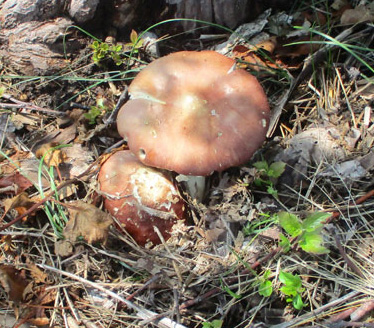







 Though way past eating
stage it certainly sounded correct. I wouldn't eat one yet anyway until
I did a spore print to confirm. These mushrooms have a light colored
spore so I cut off the stem and set the cap gills down on a black card
figuring to leave it overnight.
Though way past eating
stage it certainly sounded correct. I wouldn't eat one yet anyway until
I did a spore print to confirm. These mushrooms have a light colored
spore so I cut off the stem and set the cap gills down on a black card
figuring to leave it overnight. We were familiar with Chaga from several directions. Many years ago
we were involved in the local PowWow scene. Chaga was (is) a popular
pipe and incense ingredient, having a pleasant sweet smell and Native
American significance. And a friend uses it as a healing herb for
arthritis. But it was my fairly recent interest in growing edible
mushrooms that brought Chaga into our kitchen, and it didn't have far to
travel as it is growing on one of two large birch trees that flank the
back of our house. They were there when we chose this spot to put our
dwelling. The Chaga came later, growing in and around a fairly large
hole on the south side of one tree. We knew it was there, of course, but
didn't know it was a mushroom, albeit quite a hard one. It's not what
one normally thinks of as a mushroom. Our only thought about it was to
hope that if the tree chooses to break at that spot that it falls away
from the house.
We were familiar with Chaga from several directions. Many years ago
we were involved in the local PowWow scene. Chaga was (is) a popular
pipe and incense ingredient, having a pleasant sweet smell and Native
American significance. And a friend uses it as a healing herb for
arthritis. But it was my fairly recent interest in growing edible
mushrooms that brought Chaga into our kitchen, and it didn't have far to
travel as it is growing on one of two large birch trees that flank the
back of our house. They were there when we chose this spot to put our
dwelling. The Chaga came later, growing in and around a fairly large
hole on the south side of one tree. We knew it was there, of course, but
didn't know it was a mushroom, albeit quite a hard one. It's not what
one normally thinks of as a mushroom. Our only thought about it was to
hope that if the tree chooses to break at that spot that it falls away
from the house.


 After all these years, right there in the garden. Well, they
do
say (and we do agree) that what is in your mind becomes in your life,
and morels had certainly been in my mind. When Steve came out he glanced
down near his feet and there close by on the south side of the rhubarb
was another morel, smaller but certainly edible size. Later I discovered
a still smaller one on the other side of the patch, nestled in the
grass. Why by the rhubarb? Maybe for no particular reason but it might
be because I often mulch the rhubarb with leaves in the fall. I shall
certainly continue that practice.
After all these years, right there in the garden. Well, they
do
say (and we do agree) that what is in your mind becomes in your life,
and morels had certainly been in my mind. When Steve came out he glanced
down near his feet and there close by on the south side of the rhubarb
was another morel, smaller but certainly edible size. Later I discovered
a still smaller one on the other side of the patch, nestled in the
grass. Why by the rhubarb? Maybe for no particular reason but it might
be because I often mulch the rhubarb with leaves in the fall. I shall
certainly continue that practice.